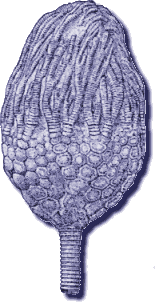Geology / Gallery

Sagenocrinites expansus
Crinoids ➚ form the bulk of many limestones of the upper Palaeozoic. The stems which attaches them to the rocks easily break off and gather in large numbers to form the tube-like fossils often seen in the Earth's older limestones. They lived in a similar manner to living corals, filtering food from the water that happens to pass their way. There are modern day relatives that are now free swimming. Like many shallow marine organisms they nearly died out completely Permian-Triassic boundary but were less affected than other groups by the extinction event at the famous Cretaceous-Tertiary extinction ➚ boundary.
They are classified as part of the diverse Echinoderm ➚ group as they show the typical scaly morphology with a five-fold symmetry (as in sea urchins and star fish). The reason that five is the important number is concerned with the way that the scales are generated to form a rigid, overlapping covering for the delicate, soft parts of this animal.
Sagenocrinites expansus lived in the Wenlock Series of the Silurian and was first identified in England.
| Division | Name |
| Phylum | Echinodermata |
| Subphylum | Crinozoa |
| Class | Crinoidea |
| Subclass | Flexibilia |
| Order | Sagenocrinida |
Fossil gallery
- Brittle Star : Lapworthia miltoni
- Trilobite : Dalmanites myops
- Crinoid : Eucalyptocrinites decorus
- Gastropod : Poleumita discorus
- Trilobite : Calymene blumenbachi
- Graptolite : Cyrtograptus murchisoni
- Sponge : Ischadites koenigi
- Conodont : Ozarkodina typica
- Brachiopod : Pentamerus oblongus
- Graptolite : Petalograptus minor
- Brachiopod : Chonetes striatellus
- Cystoid : Lepocrinetes quadrifasciatus
- Bivalve : Pteronitella retroflexa
- Graptolite : Monograptus lobiferus
- Gastropod : Platyceras haliotis
- Crinoid : Sagenocrinites expansus
- Brachiopod : Atrypa reticularis
